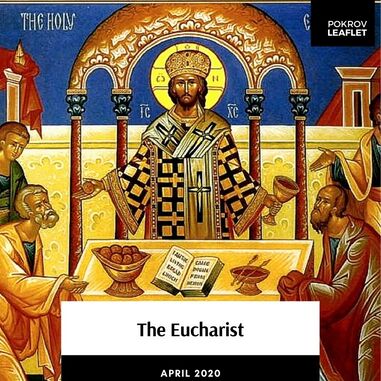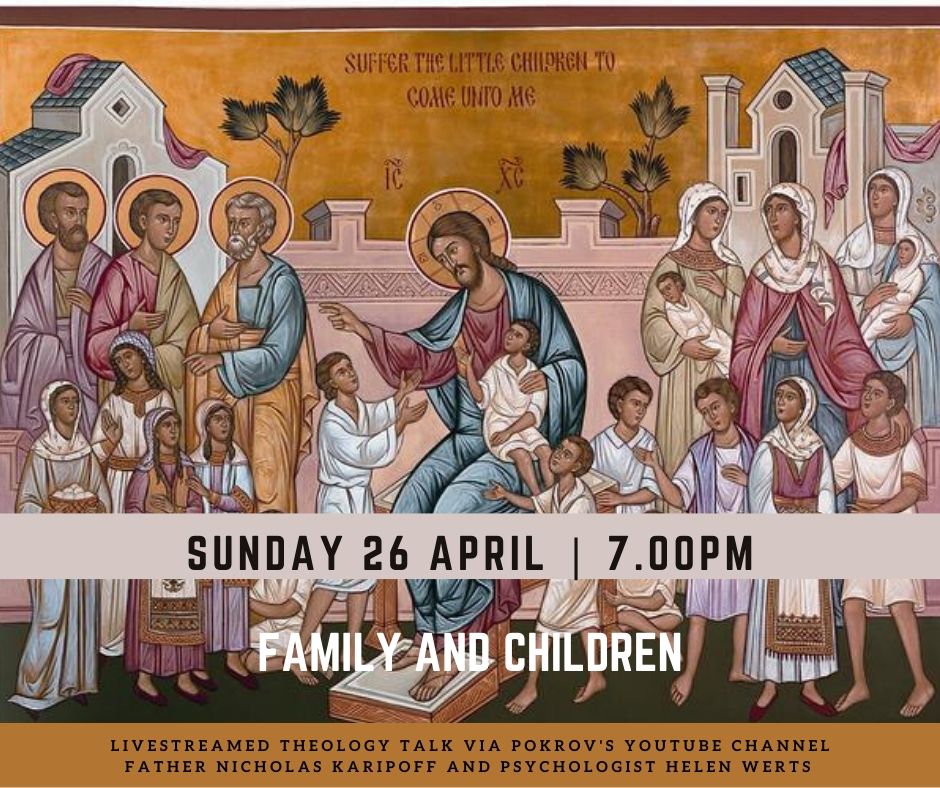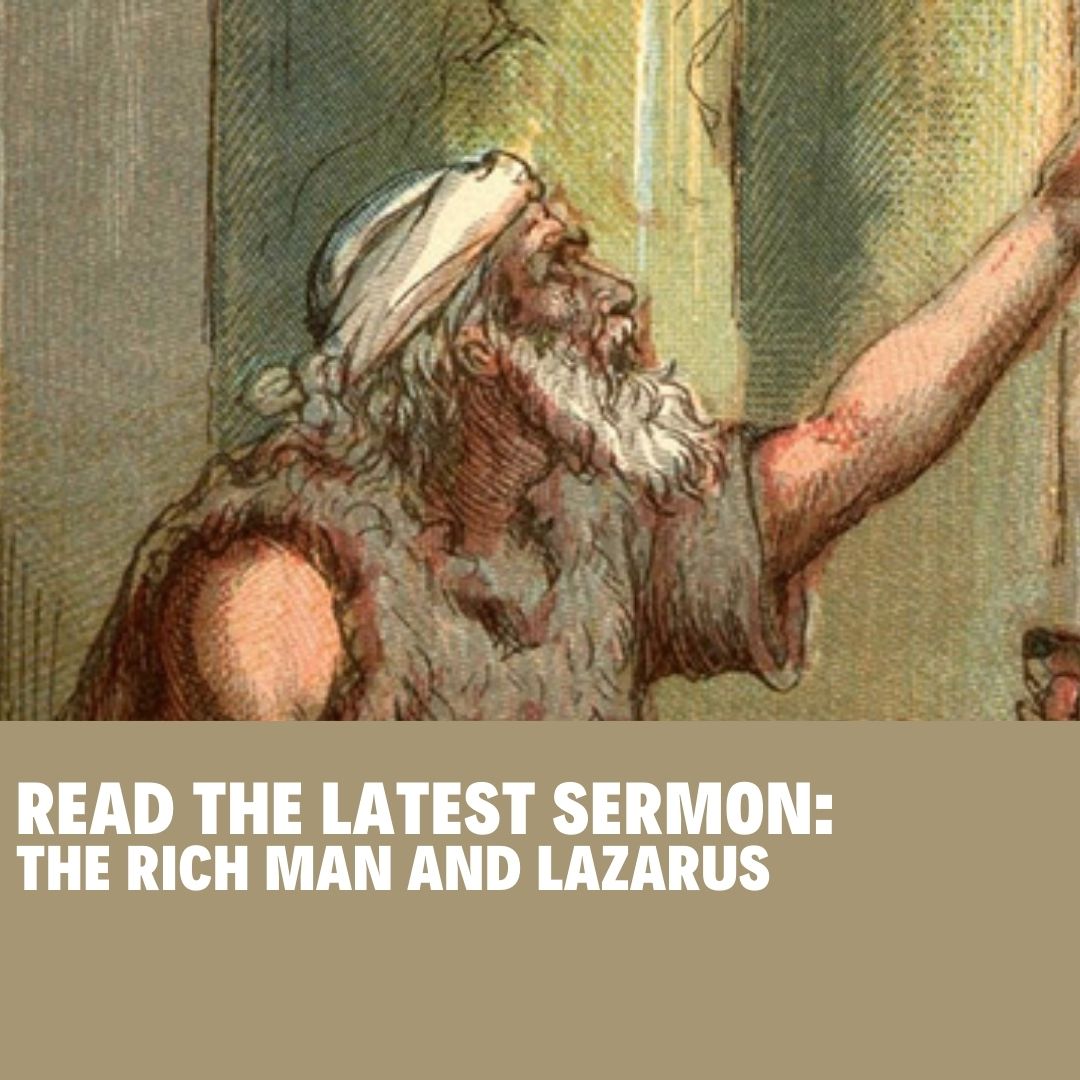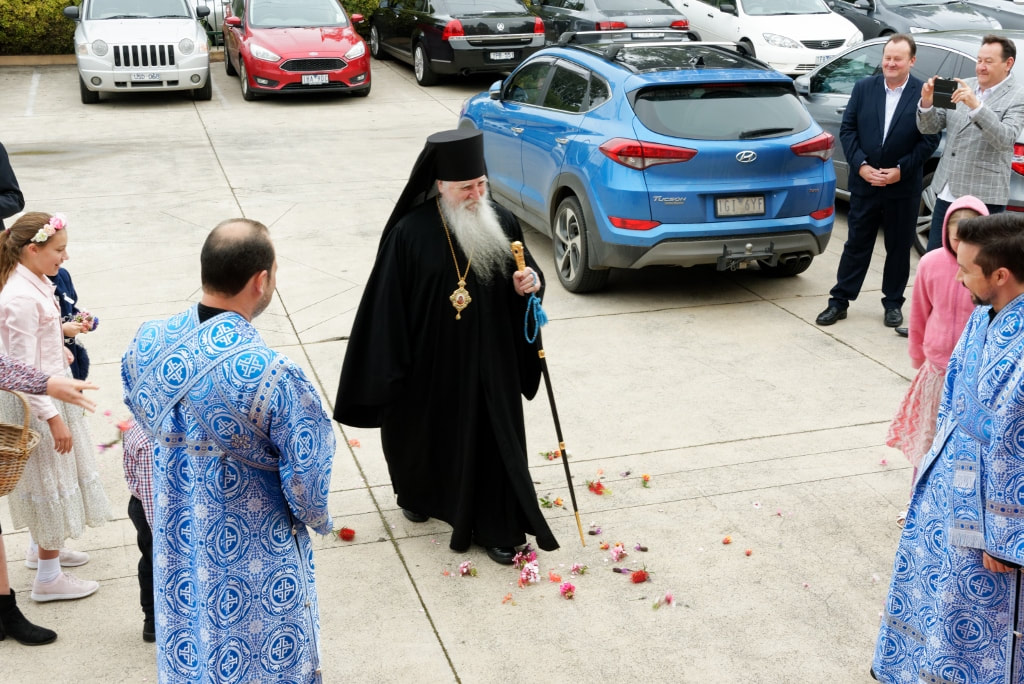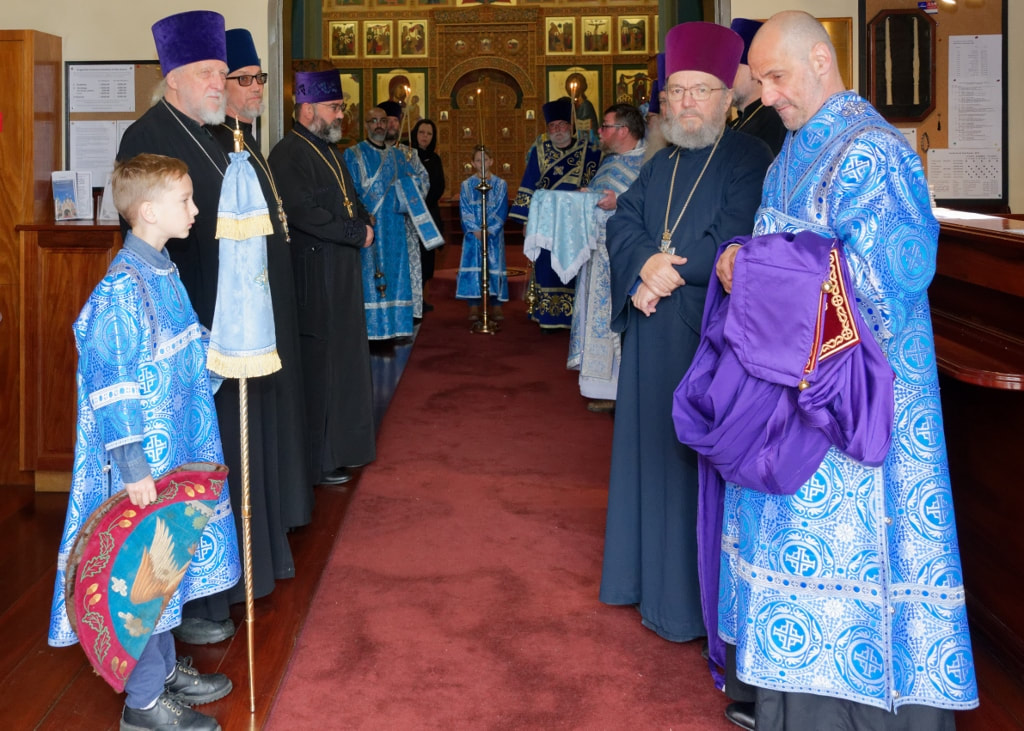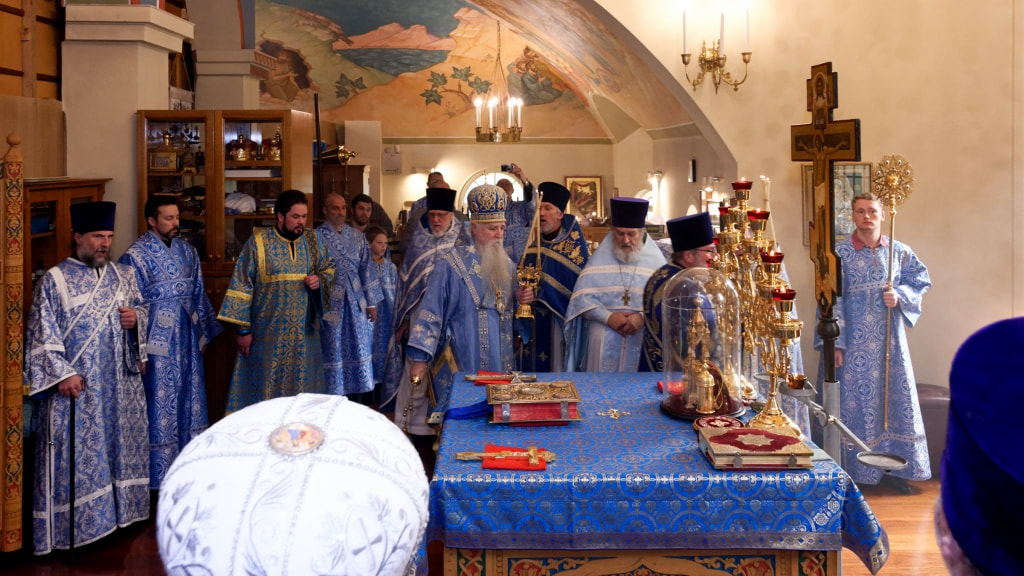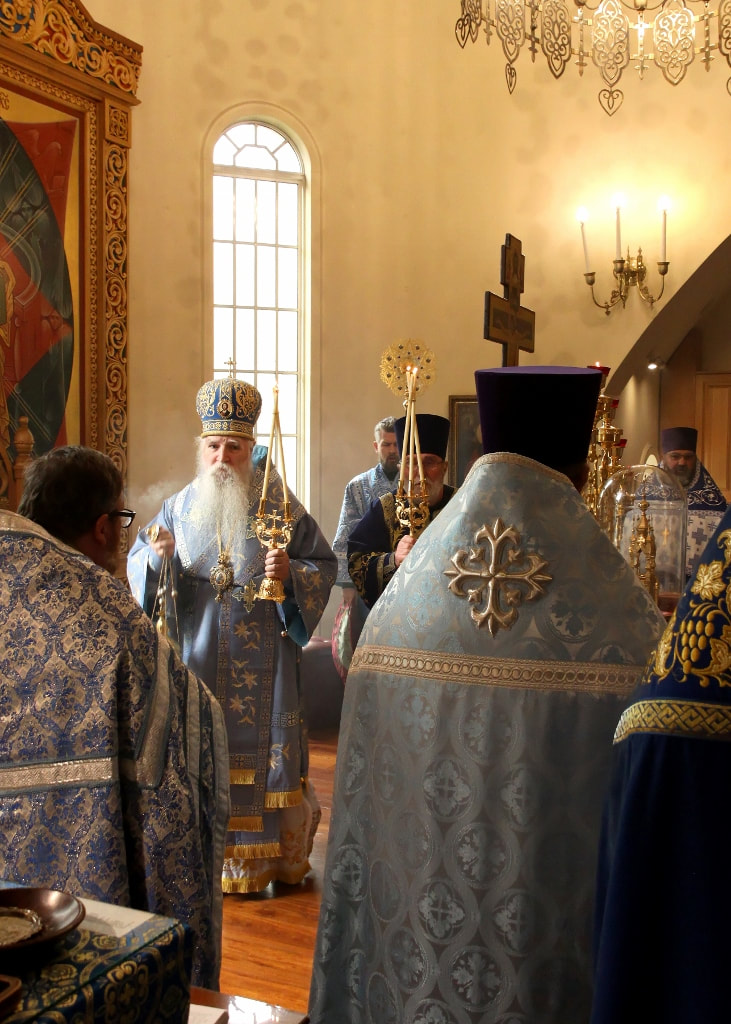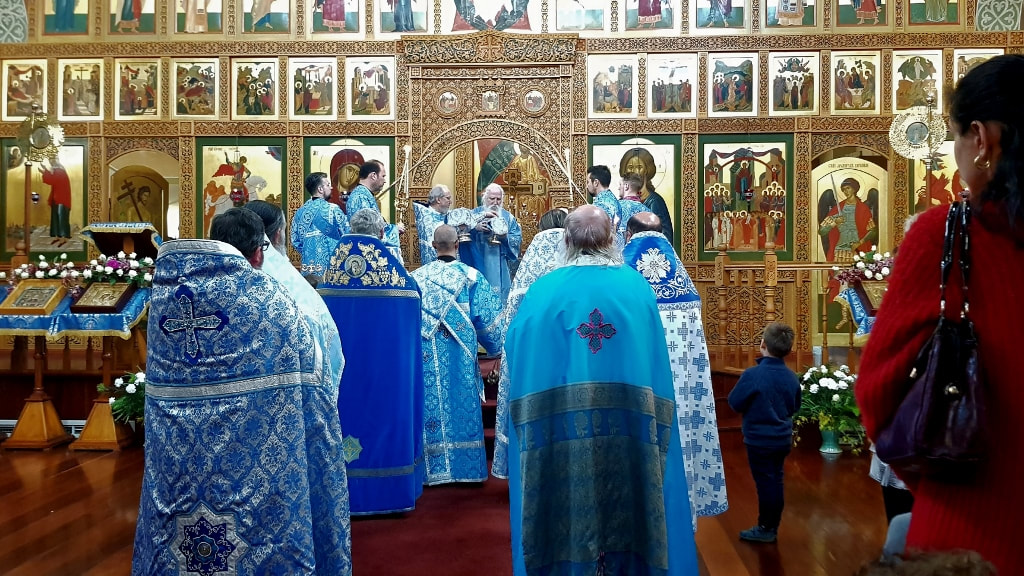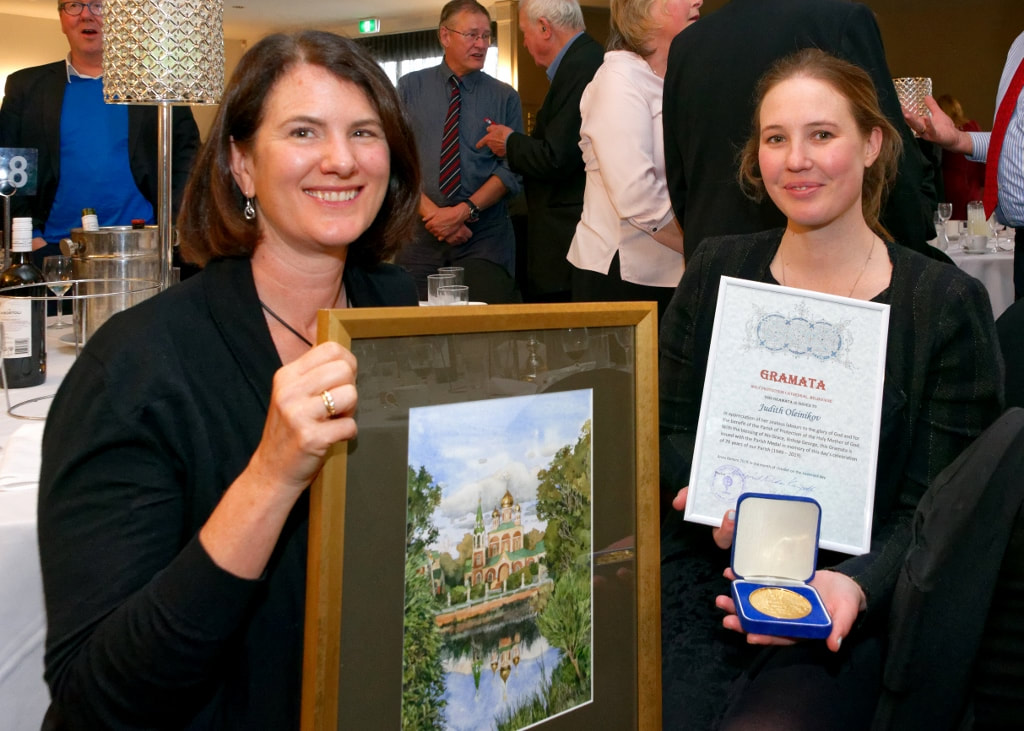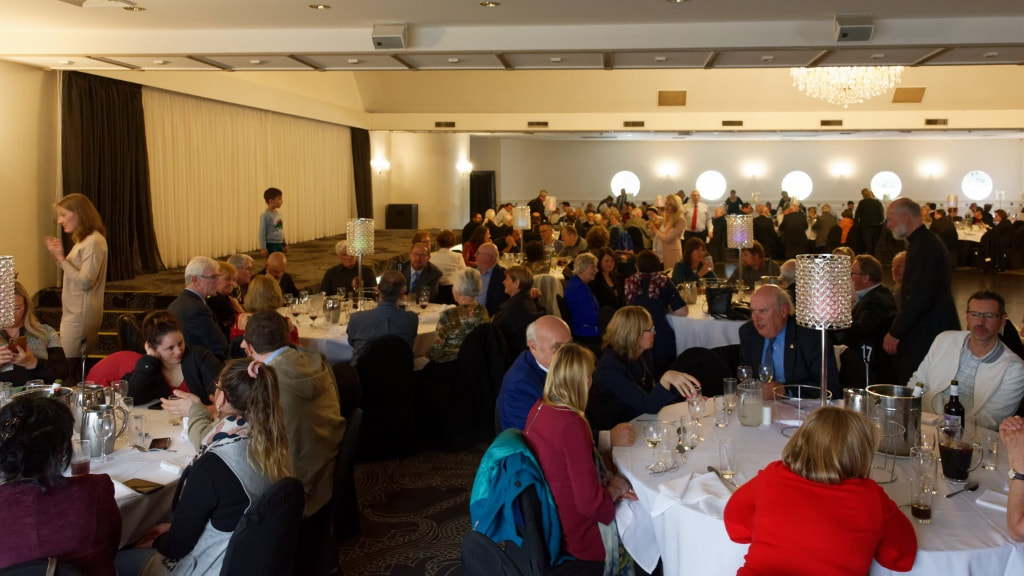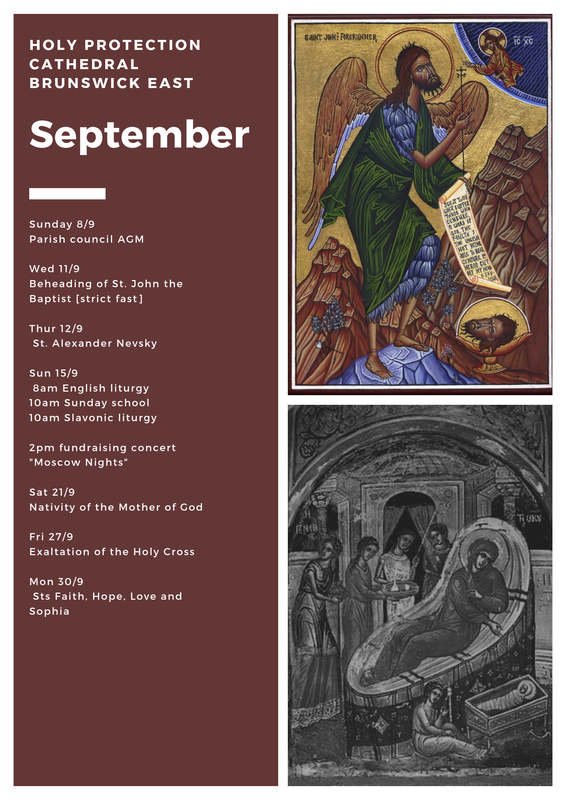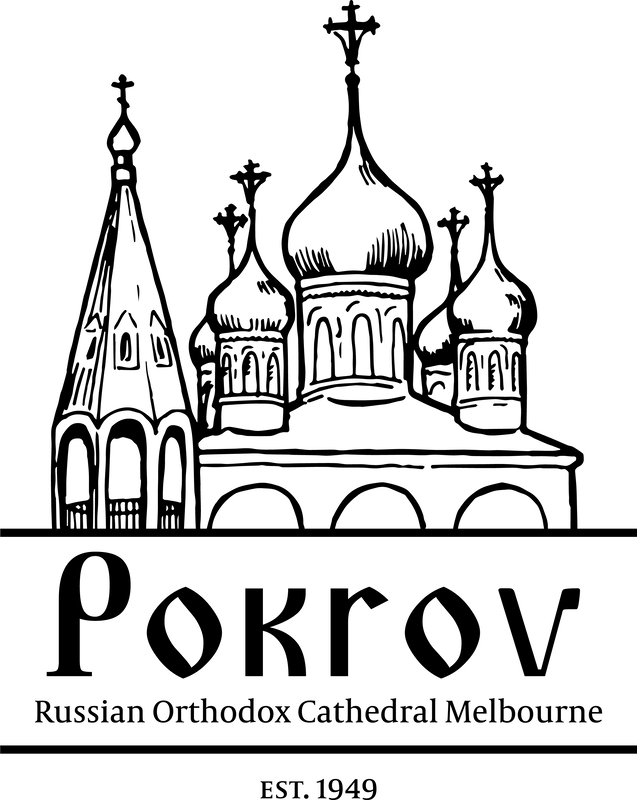|
Please tune in to our fortnightly theology lesson this Sunday at 7pm, via our YouTube channel.
1. Fr Nicholas Karipoff will give a 30 min talk on "The Creed on One God" 2. Fr Nicholas Dalinkiewicz will follow on with a talk on "Creation and Science". Questions can be texted to a number given on the night, and will be answered live. To all our beloved Sunday School families
Happy feast day of our wonderful Saints Peter and Paul! It feels so long since we have worshipped and gathered together, in Church and Sunday School. I hope everyone is doing as well as can be! I certainly really miss all the dear children and all the parents, my friends, very much. I kept thinking that maybe by now we may have been able to be together, but looks like not for a while yet. I just wanted to touch base to share some of the best links and resources that I usually use in preparation for the Sunday School lessons, just in case you might be looking for some quality things to do with the children. I totally understand there are those who already feel there is plenty on the plate and I don’t mean to add more pressure, so please don’t feel like you aren’t doing enough, or should be doing more. For others, you may like to add some ‘religious’ activities to your usual routine, or maybe just on special feast days. For me personally, faced with potentially another round of 'remote online learning,' I've decided we will tackle things quite differently this time with less focus on the school assigned tasks and more ‘doing our own thing,’ what we personally consider to be ‘the one thing needful.’ Wherever you’re at, I hope these resources will be useful in keeping us and the kids connected to our faith and the Church in these trying times when we are not there physically. I encourage and remind all that we can and should turn each of our homes into a little church, while at the same time not becoming complacent with the current situation (as Fr Nicholas said in this morning’s wonderful sermon). Praying at home is great, but can’t replace our physical connection to liturgical life. Good luck and God bless you all and please do reach out if I can help any more with the resources or for any other reason. Fiona xx P.S Feel free to forward these links on to anyone not on this email or other Orthodox families you know who might benefit. 1. https://orthodoxabc.com a wonderful site, more geared for younger children with great printouts about the most important aspects of our faith, and a video series 2. https://orthodoxpebbles.com Another great one for the younger kids, I would really encourage a good browse around the site, to see just how much it offers 3. http://ww1.antiochian.org/christianeducation/letusattend This is great because it caters to both younger and older children, with printouts and audio. The gospel is covered for each Sunday of the year (just make sure you look at the right date for our calendar!) 4. https://myocn.net/orthodox-christian-childrens-newsletter/ These short weekly bulletins are really sweet, and speak directly to the little ones. It has been running for a long time, so there’s a huge library of material! I used to like reading them out to my kids in the car on to the way to church on Sunday mornings. Good little activity pages attached to it too if you click through (word searches, lives of Saints etc). I really love them!! 5. http://dce.oca.org This is one amazing resource, something for all ages and stages and could keep you occupied for a very long time. I’ve printed out so many amazing books and activities over the years including these free downloads I printed and bound for my older 3 kids for the last lockdown, kept them busy for the 8 weeks! Amazing. http://dce.oca.org/page/activity-books/ Enjoy! :) Thank you to Courtnery Haubert for this wonderful resource. Our holy fathers and mothers left many writings that are a salve for the despairing soul. Please use this as a springboard to look deeper into patristic literature if you are so inclined! Do not grieve, for the joy of the Lord is your strength. Isaiah 41:10 The Eucharist (2)
|
| Please join us on the YouTube channel on Sunday 26th April at 7pm for the third livestreamed theology talk with Father NIcholas Karipoff. Psychologist Helen Werts will be answering questions on raising children, as well as family relationships. Please leave questions below. Thank you! |

Holy Unction will take place on Tuesday 7th April at 6pm.
It will be a closed service for now, but we will complete the anointing part of the service face to face in church, at some point in the (hopefully) near future.
If you can make the anointing please enter your name below.
Children's names can be entered if they are old enough to have confession and can attend the actual anointing.
It will be a closed service for now, but we will complete the anointing part of the service face to face in church, at some point in the (hopefully) near future.
If you can make the anointing please enter your name below.
Children's names can be entered if they are old enough to have confession and can attend the actual anointing.
|
For confession during the closure of our church, please call Father Peter who is taking confession by phone.
Home phone Mobile Father Nicholas is prepared to hold a general confession via livestreaming soon too. Please sign up to the newsletter for updates. |
| Dear fellow parish members, Closure and live streaming With the recent Government restrictions related to COVID-19, and the updated statement from Bishop George, our Church is now CLOSED to the public for services. However, services will continue with only priests, deacon, reader, choirmasters and subdeacons in attendance. The services will be live-streamed via the channel: Pokrov YouTube https://www.youtube.com/channel/UC_C_7kwTg6iu-E00Waw7y2g To get started, copy and paste the above link into your web browser. Then click on subscribe. You will then get a notification when we start streaming the next service. When watching the live feed of a service, please treat this with reverence as if you are standing in Church. Stand near an icon and put up a candle(s) if you are able to. Be a participant in the service, rather than just an observer. Appeal for financial support While in-house services will continue, the Church will no longer be able to raise funds through the sales of candles and prosphoras, buffets and the operation of the bookshop. We therefore appeal to all families and individuals to consider supporting the Church via donations online (details below). It is understood that many will unfortunately lose jobs or go on reduced hours so the donations are entirely discretionary. Furthermore, most people pay their annual membership fees at the time of the AGM in September. Can we request that members who haven not yet renewed for 2020 do so as early as possible ($150 full, $50 concession). At this stage, please make payments directly to: Account Name: ROCAM BSB: 063010 Account Number: 10055119 Description: Donation or Membership (include your name) Can you please notify the secretary at the same time in order to ensure the correct recording and issuing of receipts. Kulichi While Kulichi are still available for sale, the pick-up arrangements are unclear due to movement restrictions. Please contact the Head Sister (Luba Cowal for details, 0411090550, cowall@ozemail.com.au) Confession and communion (clergy to advise) No church clean-up on Saturday 4th April No blessing of Easter baskets The above information is subject to rapid change pending further restrictions from the Government. Any changes will be communicated via these means. Please forward this information email to others in our community, particularly any elderly people who do not have access to email. |
THE MYSTERY OF REPENTANCE
We began a new series in January on the Mysteries (Sacraments). It would have been logical to follow the description of Baptism with the Eucharist, as the first of the Mysteries opens the door to the greatest of them, which follows. However, because Lent is already upon us I thought it might be more useful at this time to discuss repentance now and leave the Eucharist closer to the Mystical Supper and celebration of the Resurrection. It is, after all, an entry into those events and the reason why the Eucharistic liturgy is not celebrated in weekdays of Lent.
There is another reason, or rather connection of the Mystery of Repentance with Baptism, which forms the foundation for a continuous renewal of our relationship with the Heavenly Father through Christ. Repentance is a renewal of Baptism, which can only happen once, as we say in the Creed. According to the patristic image - and in line with one of the Beatitudes (“Blessed are they that mourn”) – tears of repentance fill another font during our lifetime. Repentance is both a work of repairing our connection to Christ, the True Vine and a labour of co-operation with the transforming and saving grace of God.
Repentance has a number of aspects, but here let us discuss two: what it is generally speaking, and what happens in the context of sacramental confession. Our Lord began His ministry with the words: “Repent< for the Kingdom of Heaven is at hand” (Matt. 4:17). New Testament writers used a word in Greek for “repentance” which literally indicates a change of mind, but implies a change not only in thought, but also in word and deed. The expression “Kingdom of Heaven” points to the Church, the Kingdom of Christ. The Church is a community unlike any other community of human beings. Nations, tribes, clubs have rules that govern only external behaviour of their members. Christ expects His Church to be fundamentally different from organised units of humanity that operate with the carrot and the stick. Christ’s nation of New Israel (the Church) is called to rise from that level to be motivated essentially by love. That does require a change of mind, a change of life. Worldly societies value achievement of goals and often do not look at the human cost; Christianity places peace and love above any external goals. When we sin, we disconnect from the love of God and our neighbour is favour of ourselves, our selfish feelings and interests. Repentance is a humble return to the loving embrace of the Heavenly Father/ For a change of mind and heart to occur a person must not view sin only as an event, an error in an otherwise close to perfect life. The Gospel story of the rich young man () who felt that he was almost perfect should be a valuable contemplation for us in learning about what repentance is. Chris’s advice and the way it is received shows that the young man had no idea of his dominant sin, or rather passion. Real repentance (rather than a report) begins with a measure of self-knowledge. The Pharisees, like that zealously ‘righteous’ young man were further from the Kingdom of Heaven than the sinners, the publicans and the harlots. Why? Because the latter were conscious of the fact that the life was not in order on the level of the spirit. Indeed, the more we try to keep the Law of God the harder it seems to see our faults! Well, not quite. Firstly, we must not forget that we are saved only in the context of the Church, which means our neighbour, other people. Bearing each other’s burdens, we fulfil the Law of Christ (Gal. 6:2). In the process of putting up with other people, we discover who we really are. The holy fathers are unanimous in advising that life in the community is an absolute prerequisite for prayer life. We have to thank our neighbour for the scratches and bruises, which elicit sinful responses. ‘Had there been not temptations, no one would be saved’ is a popular patristic maxim.
Now a few words about confession. We should be aware of what it is, what it does and what we should bring to it. Even in the Old Testament God wanted our heart, our spirit, not superficial rites (Prov. 23:26; Is.1:10-20). It is advisable to prepare for confession by reading. Praying and thinking. We have to be focused as much as possible on our inner self. This is why dedicated times of prayer, fasting and effort to find inner peace are precious for our spirit. Traditionally Orthodox Christians made serious efforts to prepare themselves by spending a few days in a monastery. When this is not possible, an effort has to be made to attend Church services before confession, especially during Great Lent. Saturday nights throughout the year are times when quality time can be given by priest in confession. Those who have frequent communion should also come for a more comprehensive ‘tune-up’. Occasionally time can be made to meet for a longer confession and consultation. It is not fair to other people to do this when there are long ques of people for confession. Many more practical things could be said, but each person has to gain experience and nature gradually. Let us begin by remembering not to blame other people and ‘confess’ their sins. This is not repentance! Confession is us bringing our ‘broken and humbled heart’ to God (Ps. 50:10).
Archpriest Nicholas Karipoff
ТАИНСТВО ПОКАЯНИЯ
В январе мы начали новую серию Покровских листков – «Таинства». Было бы логичнее после описания таинства Крещения говорить о таинстве Евхаристии, так как первое открывает двери величайшему из последующих. Однако, потому что мы уже находимся в поприще поста, я подумал, что будет полезнее сейчас поговорить о таинстве Покаяния, а об Евхаристии - уже ближе к Тайней Вечери и Пасхе. К тому же, Покаяние – вход в эти события и причина, почему Евхаристическая литургия не совершается в будние дни Великого поста.
Есть и другая причина, или лучше сказать, связь таинства Покаяния с таинством Крещения, которое строит фундамент дальнейшего обновления нашего отношения с Небесным Отцом через Христа. Покаяние – это обновление Крещения, которое случается только один раз, как мы говорим в Символе Веры. По святоотеческому образу – и по слову одного из Блаженств («Блаженны плачущие…») – слёзы покаяния наполняют другой сосуд в течение нашей жизни. Покаяние - одновременно и усилие для восстановления связи со Христом, Истинной Лозой, - и взаимная работа по преображению и сохранению благодати Божией.
Покаяние имеет несколько аспектов, но давайте поговорим только о двух: что такое покаяние в общем и что происходит во время самого таинства исповеди. Наш Господь начал Своё служение славами: «Покайтеся, приблизилось бо Царство Небесное» (Матф. 4:17). Новозаветные писатели используют греческое слово для «покаяния», которое буквально означает изменение ума, подразумевая под этим не только мысль, но слово и дело. Выражение «Царство Небесное» указывает на Церковь, Царство Христа. Церковь – это не общество, подобное другим человеческим: нациям, племенам, клубам, которые имеют свои правила для внешнего управления поведением их членов. Христос ожидает от Своей Церкви совершенно другого по сравнению с организованными ячейками общества, которые оперируют по правилу «кнута и пряника». Христов народ Нового Израиля (Церковь) призван подняться с этого уровня по существу любовью. А это требует изменения ума, изменения жизни. Светские общества ценят достижения цели, часто не принимая во внимание цену человека; христианство ставит мир и любовь выше других внешних проявлений. Когда мы грешим, мы отлучаемся от любви Божией и нашего ближнего в угоду нам самим, нашим эгоистическим желаниям и интересам. Покаяние – смиренное возвращение в любящее объятие Небесного Отца. Изменение ума не должно смотреть на грех, как только на событие, ошибку в основном как будто идеальной жизни. Евангельский рассказ о богатом юноше (), который думал, что он почти идеален, должен быть ценным для нас созерцанием в процессе познания, что такое исповедь, покаяние. Совет Христа и реакция этого юноши, показывают, что он не имел понятия о своём главном грехе, или лучше сказать – страсти. Настоящее покаяние (а не отчёт) начинается с самопознания. Фарисеи, также как этот рьяно «праведный» юноша были также далеки от Царства Небесного, что и грешники, мытари и блудницы. Почему? Потому что последние осознавали, что их жизнь на духовном уровне неправильна. Действительно, чем больше мы стараемся соблюдать закон Божий, тем больше мы видим свои недостатки!. Хорошо, но не совсем. Во-первых, мы не должны забывать, что мы спасаемся только в контексте Церкви, а это значит, что через нашего ближнего, других людей. Неся бремя других людей, мы исполняем закон Христов (Гал. 6:2). В процессе общения с другими людьми, мы познаём, кто мы есть на самом деле. Святые Отцы единодушно утверждают, что жизнь в обществе является абсолютным условием для молитвенной жизни. Мы должны быть благодарны нашим ближним за царапины и синяки, вызывающие греховные ответы. «Если бы не было искушений, никто бы не был спасён» - популярное высказывание Святых Отцов.
Наконец, несколько слов об исповеди. Мы должны знать, что это такое, что происходит во время исповеди и что мы должны привнести. Даже в Ветхом Завете Бог хочет нашего сердца, нашего духа, а не поверхностного обряда (23:26; Ис. 1:10-20). Рекомендуется готовиться к исповеди: читать, молиться, думать. Мы должны сосредоточиться как можно больше на нашем внутреннем мире. Это почему посвящённые периоды времени для молитвы, поста и усилия обрести внутренний мир так важны для нашего духа. Традиционно православные христиане делали серьёзные усилия для подготовки себя, проводя несколько дней в монастыре. Когда это невозможно – нужно сделать усилие посещать церковные богослужения перед исповедью, особенно в течение Великого Поста. Субботние вечерние богослужения в течение всего года – время, когда священник может уделить достаточно времени для исповеди. Кто часто причащается - также должен приходить для более серьёзной «настройки». Иногда можно договориться для более продолжительной исповеди и консультации. Делать это - не справедливо по отношению к другим людям, стоящим в очереди на исповедь. Можно сказать ещё много практических вещей, но каждый человек должен набраться опыта и постепенно взрослеть. Начнём с того, чтобы помнить не осуждать других людей и «не исповедовать» их грехов. Это не покаяние! Исповедь, это когда мы приносим «своё сокрушенное и смиренное сердце» Богу (Псал.50:19).
Протоиерей Николай Карыпов
We began a new series in January on the Mysteries (Sacraments). It would have been logical to follow the description of Baptism with the Eucharist, as the first of the Mysteries opens the door to the greatest of them, which follows. However, because Lent is already upon us I thought it might be more useful at this time to discuss repentance now and leave the Eucharist closer to the Mystical Supper and celebration of the Resurrection. It is, after all, an entry into those events and the reason why the Eucharistic liturgy is not celebrated in weekdays of Lent.
There is another reason, or rather connection of the Mystery of Repentance with Baptism, which forms the foundation for a continuous renewal of our relationship with the Heavenly Father through Christ. Repentance is a renewal of Baptism, which can only happen once, as we say in the Creed. According to the patristic image - and in line with one of the Beatitudes (“Blessed are they that mourn”) – tears of repentance fill another font during our lifetime. Repentance is both a work of repairing our connection to Christ, the True Vine and a labour of co-operation with the transforming and saving grace of God.
Repentance has a number of aspects, but here let us discuss two: what it is generally speaking, and what happens in the context of sacramental confession. Our Lord began His ministry with the words: “Repent< for the Kingdom of Heaven is at hand” (Matt. 4:17). New Testament writers used a word in Greek for “repentance” which literally indicates a change of mind, but implies a change not only in thought, but also in word and deed. The expression “Kingdom of Heaven” points to the Church, the Kingdom of Christ. The Church is a community unlike any other community of human beings. Nations, tribes, clubs have rules that govern only external behaviour of their members. Christ expects His Church to be fundamentally different from organised units of humanity that operate with the carrot and the stick. Christ’s nation of New Israel (the Church) is called to rise from that level to be motivated essentially by love. That does require a change of mind, a change of life. Worldly societies value achievement of goals and often do not look at the human cost; Christianity places peace and love above any external goals. When we sin, we disconnect from the love of God and our neighbour is favour of ourselves, our selfish feelings and interests. Repentance is a humble return to the loving embrace of the Heavenly Father/ For a change of mind and heart to occur a person must not view sin only as an event, an error in an otherwise close to perfect life. The Gospel story of the rich young man () who felt that he was almost perfect should be a valuable contemplation for us in learning about what repentance is. Chris’s advice and the way it is received shows that the young man had no idea of his dominant sin, or rather passion. Real repentance (rather than a report) begins with a measure of self-knowledge. The Pharisees, like that zealously ‘righteous’ young man were further from the Kingdom of Heaven than the sinners, the publicans and the harlots. Why? Because the latter were conscious of the fact that the life was not in order on the level of the spirit. Indeed, the more we try to keep the Law of God the harder it seems to see our faults! Well, not quite. Firstly, we must not forget that we are saved only in the context of the Church, which means our neighbour, other people. Bearing each other’s burdens, we fulfil the Law of Christ (Gal. 6:2). In the process of putting up with other people, we discover who we really are. The holy fathers are unanimous in advising that life in the community is an absolute prerequisite for prayer life. We have to thank our neighbour for the scratches and bruises, which elicit sinful responses. ‘Had there been not temptations, no one would be saved’ is a popular patristic maxim.
Now a few words about confession. We should be aware of what it is, what it does and what we should bring to it. Even in the Old Testament God wanted our heart, our spirit, not superficial rites (Prov. 23:26; Is.1:10-20). It is advisable to prepare for confession by reading. Praying and thinking. We have to be focused as much as possible on our inner self. This is why dedicated times of prayer, fasting and effort to find inner peace are precious for our spirit. Traditionally Orthodox Christians made serious efforts to prepare themselves by spending a few days in a monastery. When this is not possible, an effort has to be made to attend Church services before confession, especially during Great Lent. Saturday nights throughout the year are times when quality time can be given by priest in confession. Those who have frequent communion should also come for a more comprehensive ‘tune-up’. Occasionally time can be made to meet for a longer confession and consultation. It is not fair to other people to do this when there are long ques of people for confession. Many more practical things could be said, but each person has to gain experience and nature gradually. Let us begin by remembering not to blame other people and ‘confess’ their sins. This is not repentance! Confession is us bringing our ‘broken and humbled heart’ to God (Ps. 50:10).
Archpriest Nicholas Karipoff
ТАИНСТВО ПОКАЯНИЯ
В январе мы начали новую серию Покровских листков – «Таинства». Было бы логичнее после описания таинства Крещения говорить о таинстве Евхаристии, так как первое открывает двери величайшему из последующих. Однако, потому что мы уже находимся в поприще поста, я подумал, что будет полезнее сейчас поговорить о таинстве Покаяния, а об Евхаристии - уже ближе к Тайней Вечери и Пасхе. К тому же, Покаяние – вход в эти события и причина, почему Евхаристическая литургия не совершается в будние дни Великого поста.
Есть и другая причина, или лучше сказать, связь таинства Покаяния с таинством Крещения, которое строит фундамент дальнейшего обновления нашего отношения с Небесным Отцом через Христа. Покаяние – это обновление Крещения, которое случается только один раз, как мы говорим в Символе Веры. По святоотеческому образу – и по слову одного из Блаженств («Блаженны плачущие…») – слёзы покаяния наполняют другой сосуд в течение нашей жизни. Покаяние - одновременно и усилие для восстановления связи со Христом, Истинной Лозой, - и взаимная работа по преображению и сохранению благодати Божией.
Покаяние имеет несколько аспектов, но давайте поговорим только о двух: что такое покаяние в общем и что происходит во время самого таинства исповеди. Наш Господь начал Своё служение славами: «Покайтеся, приблизилось бо Царство Небесное» (Матф. 4:17). Новозаветные писатели используют греческое слово для «покаяния», которое буквально означает изменение ума, подразумевая под этим не только мысль, но слово и дело. Выражение «Царство Небесное» указывает на Церковь, Царство Христа. Церковь – это не общество, подобное другим человеческим: нациям, племенам, клубам, которые имеют свои правила для внешнего управления поведением их членов. Христос ожидает от Своей Церкви совершенно другого по сравнению с организованными ячейками общества, которые оперируют по правилу «кнута и пряника». Христов народ Нового Израиля (Церковь) призван подняться с этого уровня по существу любовью. А это требует изменения ума, изменения жизни. Светские общества ценят достижения цели, часто не принимая во внимание цену человека; христианство ставит мир и любовь выше других внешних проявлений. Когда мы грешим, мы отлучаемся от любви Божией и нашего ближнего в угоду нам самим, нашим эгоистическим желаниям и интересам. Покаяние – смиренное возвращение в любящее объятие Небесного Отца. Изменение ума не должно смотреть на грех, как только на событие, ошибку в основном как будто идеальной жизни. Евангельский рассказ о богатом юноше (), который думал, что он почти идеален, должен быть ценным для нас созерцанием в процессе познания, что такое исповедь, покаяние. Совет Христа и реакция этого юноши, показывают, что он не имел понятия о своём главном грехе, или лучше сказать – страсти. Настоящее покаяние (а не отчёт) начинается с самопознания. Фарисеи, также как этот рьяно «праведный» юноша были также далеки от Царства Небесного, что и грешники, мытари и блудницы. Почему? Потому что последние осознавали, что их жизнь на духовном уровне неправильна. Действительно, чем больше мы стараемся соблюдать закон Божий, тем больше мы видим свои недостатки!. Хорошо, но не совсем. Во-первых, мы не должны забывать, что мы спасаемся только в контексте Церкви, а это значит, что через нашего ближнего, других людей. Неся бремя других людей, мы исполняем закон Христов (Гал. 6:2). В процессе общения с другими людьми, мы познаём, кто мы есть на самом деле. Святые Отцы единодушно утверждают, что жизнь в обществе является абсолютным условием для молитвенной жизни. Мы должны быть благодарны нашим ближним за царапины и синяки, вызывающие греховные ответы. «Если бы не было искушений, никто бы не был спасён» - популярное высказывание Святых Отцов.
Наконец, несколько слов об исповеди. Мы должны знать, что это такое, что происходит во время исповеди и что мы должны привнести. Даже в Ветхом Завете Бог хочет нашего сердца, нашего духа, а не поверхностного обряда (23:26; Ис. 1:10-20). Рекомендуется готовиться к исповеди: читать, молиться, думать. Мы должны сосредоточиться как можно больше на нашем внутреннем мире. Это почему посвящённые периоды времени для молитвы, поста и усилия обрести внутренний мир так важны для нашего духа. Традиционно православные христиане делали серьёзные усилия для подготовки себя, проводя несколько дней в монастыре. Когда это невозможно – нужно сделать усилие посещать церковные богослужения перед исповедью, особенно в течение Великого Поста. Субботние вечерние богослужения в течение всего года – время, когда священник может уделить достаточно времени для исповеди. Кто часто причащается - также должен приходить для более серьёзной «настройки». Иногда можно договориться для более продолжительной исповеди и консультации. Делать это - не справедливо по отношению к другим людям, стоящим в очереди на исповедь. Можно сказать ещё много практических вещей, но каждый человек должен набраться опыта и постепенно взрослеть. Начнём с того, чтобы помнить не осуждать других людей и «не исповедовать» их грехов. Это не покаяние! Исповедь, это когда мы приносим «своё сокрушенное и смиренное сердце» Богу (Псал.50:19).
Протоиерей Николай Карыпов
Images from Fiona Polorotoff, "Home Church".
| Some useful links to text for services for those following the live stream or private prayer at home. http://www.orthodox.net/services/#S12 http://www.saintjonah.org/services/formatedhorologion.htm http://www.saintjonah.org/services/ http://www.st-sergius.org/services.html |

COVID-19 Response from Pokrov, Melbourne
Saturday 21 March, 2020
* * *
As you may be aware, this week indoor gatherings numbering over 100 people were banned in Australia, (as well as outdoor gatherings over 500) as a response to the Coronavirus outbreak.
Furthermore, yesterday Prime Minister Scott Morrison explained that there should be ample room to accommodate those gathering indoors – therefore we are capping services at Pokrov to 100 attendees inclusive of choir and clergy.
CHURCH SERVICES AT POKROV THIS WEEKEND:
On Saturday 21 March services will run as normal (9.30am liturgy and 6pm vigil).
On Sunday 22nd March there will be two liturgies
7:45 am - English liturgy
10:15 am - Slavonic liturgy
To keep in line with the current law, only the first 100 people will be admitted to the service.
Those that receive confession at the vigil are strongly encouraged to arrive early to avoid missing out. If you are at risk, required to self-isolate or have a confirmed case of COVID-19 please do not attend the premises.
Those that attend are asked to cross themselves and bow when venerating icons instead of kissing them. Please avoid physical contact with others as well - priests may be greeted with a bow.
Services will also be live-streamed to the public via the Pokrov YouTube site. Subscribe to the YouTube page here.
We had a trial run yesterday and will iron out some audio problems shortly. Please treat the streamed services with due reverence.
Staying home? You can find copies of the Lenten Triodion online to help you follow the service.
If you have any questions please email Father Nicholas Karipoff:
fr.karipoff@gmail.com
God bless,
Parish Council and Father Nicholas Karipoff
Statement Concerning Conducting Church Life
During the Pandemic
Bishop George
To the Clergy, Monastics, and Laity of the Australian-New Zealand Diocese,
“Fear not, little flock, for it is your Father’s good pleasure to give you the kingdom” (Luke 12:32).
In these last days, as the seals in the Book of Revelation are being opened (according to the word of St. Paisios of Mt. Athos), we must always hearken to these words of our Saviour spoken to His disciples and to all of us: “Fear not.”
We have read about the various regulations being enacted in dioceses throughout the world in response to the severity of the COVID-19 outbreak in their regions and the restrictions being enforced by the local governments. Here in Australia we have just heard of the new restriction of having four (4) sq. metres of space for every occupant of a gathering of less than one hundred (100) people, with more than one hundred (100) being forbidden. Outdoors we are limited to gatherings of five hundred (500) people. We do not know if any kind of gatherings will be allowed in the near future. We ask all of our church communities to obey their local government requirements.
Concerning church services, if the space in your church is insufficient for you to comply to these rules, or if we are forbidden to have any indoor gatherings in the future, you may have outdoor liturgies and services, perhaps with the altar positioned in the entrance of the church.
We will continue to administer the Holy Mysteries as we have always done. Zapivka should be given with disposable paper cups, and burned afterwards. The veneration of icons and the cross and the greeting of the priest may continue as normal, alternatively it is also acceptable for the faithful to bow to the icons and the priest. The faithful may take the antidoron themselves at the end of liturgy.
As this is a contagious disease all the faithful should be encouraged to maintain good personal hygiene and avoid unnecessary contact in order to keep from passing on the contagion to one another.
The elderly, those who are sick and those whose health is compromised and are especially vulnerable to the disease are encouraged to stay at home until the situation improves. They should contact their priest in order to receive the sacraments of Confession and Holy Communion. It is also now possible to watch the divine services via live-streaming. [At the present time the Pokrov Sobor in Melbourne (Slavonic and English), the Vladimir Icon Parish in Rocklea (Slavonic), and the Holy Annunciation Parish in Brisbane (English) are live-streaming their services.]
All Russian church schools should cancel classes until further notice and all Holy Unction services scheduled for this Lenten period should be cancelled.
Let us remember that everything is from the hand of God, and “all things work together for good to them that love God” (Rom. 8:28). In the third century, during a terrible pandemic, over 5,000 perished every day in Rome. Some cities lost more than 60% of their population. During that time people panicked and abandoned the sick and the dying, except for the Christians. They displayed great faith, compassion, and steadfastness as they cared for the sick, the disabled, and even strangers. Let us emulate these early Christians, showing that we are worthy of also being called Christians. Let us seek out those that may be in need and offer whatever assistance we can, whether it be physical or spiritual. “In your patience possess ye your souls” (Luke 21:19).
+Bishop George of Canberra
Administrator of the Australia-New Zealand Diocese
of the Russian Orthodox Church Outside of Russia
We ask that the following prayer be added to every liturgy and that copies of the prayer be distributed to the laity so that they may add it to their daily prayers.
* * * * * * * *
Prayer for salvation from the coronavirus and other ills
O Lord Jesus Christ, our God!
Look down on all who are suffering from the viral contagion. Do not let them to be left without the hope of life ahead, give them courage and faith in Thy all-powerful help.
Lord, guard us all from serious illnesses.
Grant forgiveness and remit the sins and transgressions of all those who cannot be healed, who are leaving this world in mortal anguish. Send Thy Angels to receive their souls.
With Thy right hand, O Lord, purify the earth, the air and the waters from the destructive consequences of the current calamity.
Protect us through the prayers of our Most Pure Lady the Mother of God and of all Thy saints. Amen
Заявление относительно проведения церковных служб
во время эпидемии
Священнослужителям, монашествующим и мирянам Австралийско-Новозеландской Епархии.
«Не бойся, малое стадо! Ибо Отец ваш благоволил дать вам царство» (Лк.12:32).
В эти последние дни, когда по словам святого старца Паисия Афонского, печати книги Откровения открываются, мы должны внимать этим словам нашего Спасителя Его ученикам и нам всем: «Не бойтесь».
Мы читали разные правила, которые предписывается исполнять по разным епархиям по всему миру в отношении серьёзности вспыхнувшей эпидемии COVID-19, и ограничений, введённых местными властями. У нас в Австралии мы только что узнали о таких ограничениях: иметь 4 м2 площади на каждого, где собирается вместе внутри помещения не более 100 человек. На открытом воздухе число собравшихся ограничено до 500. Мы не знаем, если в ближайшем будущем будет вообще разрешено собираться вместе. Просьба ко всем церковным обществам исполнять требования местной власти.
В отношении церковных служб: если размер храма не позволяет исполнять это требование, или если в будущем будет запрещено собираться внутри помещений, можно совершать литургию на воздухе, используя притвор как алтарь.
Святое причастие вы будете получать, как обычно. Запивка должна разливаться в бумажные стаканчики, которые после использования будут сожжены. Поклонение иконам, целование креста и принятие благословения от священника могут быть как всегда, но можно также просто поклониться иконам и священнику. Верующие могут брать антидор сами в конце литургии.
Так как это заразная болезнь, все верующие должны соблюдать необходимые правила гигиены и избегать ненужных контактов во избежание передачи заразы другим.
Пожилым людям, болящим или у которых проблемы со здоровьем и, особенно, подверженным этой болезни – рекомендуется оставаться дома до тех пор, пока ситуация не улучшится. Они должны связаться со своим священником, чтобы получить таинства исповеди и причастия. Также возможно смотреть божественные службы в прямой трансляции (в настоящее это уже устроено в Свято-Покровском Соборе в Мельбурне (на двух языках), в приходе Владимирской иконы Божией Матери в Рокли (на церковно-славянском) и Благовещенском приходе в Брисбене (на английском языке).
Все Русские приходские школы должны отменить занятия до последующего сообщения. Общее Соборование, которое обычно совершается во время Великого Поста, также должно быть отменено.
Мы должны помнить, что всё в руках Божиих, и «… что любящим Бога, призванным по Его изволению, всё содействует ко благу» (Рим.8:28). В III веке, во время ужасной эпидемии, в Риме умирало свыше 5-ти тысяч человек каждый день. Некоторые города потеряли более 60% населения. На людей напала паника, они оставляли больных умирать без всякой помощи. А христиане продолжали помогать больным, увечным и даже чужим, показывая свою крепкую веру, сострадание и стойкость. Будем подражать древним христианам, показывая, что мы тоже достойны называться христианами. Будем помогать нуждающимся в помощи, оказывая любую поддержку, которую мы можем предложить – физическую или духовную. «Терпением вашим спасайте души ваши» (Лк.21:19).
+ Георгий, Епископ Канберрский
Администратор Австралийско-Новозеландской Епархии
Русской Православной Церкви Заграницей
Прошу читать нижеследующую молитву на каждой литургии и раздать копии мирянам, чтобы они могли добавить её к своим ежедневым молитвам.
Saturday 21 March, 2020
* * *
As you may be aware, this week indoor gatherings numbering over 100 people were banned in Australia, (as well as outdoor gatherings over 500) as a response to the Coronavirus outbreak.
Furthermore, yesterday Prime Minister Scott Morrison explained that there should be ample room to accommodate those gathering indoors – therefore we are capping services at Pokrov to 100 attendees inclusive of choir and clergy.
CHURCH SERVICES AT POKROV THIS WEEKEND:
On Saturday 21 March services will run as normal (9.30am liturgy and 6pm vigil).
On Sunday 22nd March there will be two liturgies
7:45 am - English liturgy
10:15 am - Slavonic liturgy
To keep in line with the current law, only the first 100 people will be admitted to the service.
Those that receive confession at the vigil are strongly encouraged to arrive early to avoid missing out. If you are at risk, required to self-isolate or have a confirmed case of COVID-19 please do not attend the premises.
Those that attend are asked to cross themselves and bow when venerating icons instead of kissing them. Please avoid physical contact with others as well - priests may be greeted with a bow.
Services will also be live-streamed to the public via the Pokrov YouTube site. Subscribe to the YouTube page here.
We had a trial run yesterday and will iron out some audio problems shortly. Please treat the streamed services with due reverence.
Staying home? You can find copies of the Lenten Triodion online to help you follow the service.
If you have any questions please email Father Nicholas Karipoff:
fr.karipoff@gmail.com
God bless,
Parish Council and Father Nicholas Karipoff
Statement Concerning Conducting Church Life
During the Pandemic
Bishop George
To the Clergy, Monastics, and Laity of the Australian-New Zealand Diocese,
“Fear not, little flock, for it is your Father’s good pleasure to give you the kingdom” (Luke 12:32).
In these last days, as the seals in the Book of Revelation are being opened (according to the word of St. Paisios of Mt. Athos), we must always hearken to these words of our Saviour spoken to His disciples and to all of us: “Fear not.”
We have read about the various regulations being enacted in dioceses throughout the world in response to the severity of the COVID-19 outbreak in their regions and the restrictions being enforced by the local governments. Here in Australia we have just heard of the new restriction of having four (4) sq. metres of space for every occupant of a gathering of less than one hundred (100) people, with more than one hundred (100) being forbidden. Outdoors we are limited to gatherings of five hundred (500) people. We do not know if any kind of gatherings will be allowed in the near future. We ask all of our church communities to obey their local government requirements.
Concerning church services, if the space in your church is insufficient for you to comply to these rules, or if we are forbidden to have any indoor gatherings in the future, you may have outdoor liturgies and services, perhaps with the altar positioned in the entrance of the church.
We will continue to administer the Holy Mysteries as we have always done. Zapivka should be given with disposable paper cups, and burned afterwards. The veneration of icons and the cross and the greeting of the priest may continue as normal, alternatively it is also acceptable for the faithful to bow to the icons and the priest. The faithful may take the antidoron themselves at the end of liturgy.
As this is a contagious disease all the faithful should be encouraged to maintain good personal hygiene and avoid unnecessary contact in order to keep from passing on the contagion to one another.
The elderly, those who are sick and those whose health is compromised and are especially vulnerable to the disease are encouraged to stay at home until the situation improves. They should contact their priest in order to receive the sacraments of Confession and Holy Communion. It is also now possible to watch the divine services via live-streaming. [At the present time the Pokrov Sobor in Melbourne (Slavonic and English), the Vladimir Icon Parish in Rocklea (Slavonic), and the Holy Annunciation Parish in Brisbane (English) are live-streaming their services.]
All Russian church schools should cancel classes until further notice and all Holy Unction services scheduled for this Lenten period should be cancelled.
Let us remember that everything is from the hand of God, and “all things work together for good to them that love God” (Rom. 8:28). In the third century, during a terrible pandemic, over 5,000 perished every day in Rome. Some cities lost more than 60% of their population. During that time people panicked and abandoned the sick and the dying, except for the Christians. They displayed great faith, compassion, and steadfastness as they cared for the sick, the disabled, and even strangers. Let us emulate these early Christians, showing that we are worthy of also being called Christians. Let us seek out those that may be in need and offer whatever assistance we can, whether it be physical or spiritual. “In your patience possess ye your souls” (Luke 21:19).
+Bishop George of Canberra
Administrator of the Australia-New Zealand Diocese
of the Russian Orthodox Church Outside of Russia
We ask that the following prayer be added to every liturgy and that copies of the prayer be distributed to the laity so that they may add it to their daily prayers.
* * * * * * * *
Prayer for salvation from the coronavirus and other ills
O Lord Jesus Christ, our God!
Look down on all who are suffering from the viral contagion. Do not let them to be left without the hope of life ahead, give them courage and faith in Thy all-powerful help.
Lord, guard us all from serious illnesses.
Grant forgiveness and remit the sins and transgressions of all those who cannot be healed, who are leaving this world in mortal anguish. Send Thy Angels to receive their souls.
With Thy right hand, O Lord, purify the earth, the air and the waters from the destructive consequences of the current calamity.
Protect us through the prayers of our Most Pure Lady the Mother of God and of all Thy saints. Amen
Заявление относительно проведения церковных служб
во время эпидемии
Священнослужителям, монашествующим и мирянам Австралийско-Новозеландской Епархии.
«Не бойся, малое стадо! Ибо Отец ваш благоволил дать вам царство» (Лк.12:32).
В эти последние дни, когда по словам святого старца Паисия Афонского, печати книги Откровения открываются, мы должны внимать этим словам нашего Спасителя Его ученикам и нам всем: «Не бойтесь».
Мы читали разные правила, которые предписывается исполнять по разным епархиям по всему миру в отношении серьёзности вспыхнувшей эпидемии COVID-19, и ограничений, введённых местными властями. У нас в Австралии мы только что узнали о таких ограничениях: иметь 4 м2 площади на каждого, где собирается вместе внутри помещения не более 100 человек. На открытом воздухе число собравшихся ограничено до 500. Мы не знаем, если в ближайшем будущем будет вообще разрешено собираться вместе. Просьба ко всем церковным обществам исполнять требования местной власти.
В отношении церковных служб: если размер храма не позволяет исполнять это требование, или если в будущем будет запрещено собираться внутри помещений, можно совершать литургию на воздухе, используя притвор как алтарь.
Святое причастие вы будете получать, как обычно. Запивка должна разливаться в бумажные стаканчики, которые после использования будут сожжены. Поклонение иконам, целование креста и принятие благословения от священника могут быть как всегда, но можно также просто поклониться иконам и священнику. Верующие могут брать антидор сами в конце литургии.
Так как это заразная болезнь, все верующие должны соблюдать необходимые правила гигиены и избегать ненужных контактов во избежание передачи заразы другим.
Пожилым людям, болящим или у которых проблемы со здоровьем и, особенно, подверженным этой болезни – рекомендуется оставаться дома до тех пор, пока ситуация не улучшится. Они должны связаться со своим священником, чтобы получить таинства исповеди и причастия. Также возможно смотреть божественные службы в прямой трансляции (в настоящее это уже устроено в Свято-Покровском Соборе в Мельбурне (на двух языках), в приходе Владимирской иконы Божией Матери в Рокли (на церковно-славянском) и Благовещенском приходе в Брисбене (на английском языке).
Все Русские приходские школы должны отменить занятия до последующего сообщения. Общее Соборование, которое обычно совершается во время Великого Поста, также должно быть отменено.
Мы должны помнить, что всё в руках Божиих, и «… что любящим Бога, призванным по Его изволению, всё содействует ко благу» (Рим.8:28). В III веке, во время ужасной эпидемии, в Риме умирало свыше 5-ти тысяч человек каждый день. Некоторые города потеряли более 60% населения. На людей напала паника, они оставляли больных умирать без всякой помощи. А христиане продолжали помогать больным, увечным и даже чужим, показывая свою крепкую веру, сострадание и стойкость. Будем подражать древним христианам, показывая, что мы тоже достойны называться христианами. Будем помогать нуждающимся в помощи, оказывая любую поддержку, которую мы можем предложить – физическую или духовную. «Терпением вашим спасайте души ваши» (Лк.21:19).
+ Георгий, Епископ Канберрский
Администратор Австралийско-Новозеландской Епархии
Русской Православной Церкви Заграницей
Прошу читать нижеследующую молитву на каждой литургии и раздать копии мирянам, чтобы они могли добавить её к своим ежедневым молитвам.
For the fourth annual Pokrov Family Camp we are heading back to the YMCA-managed Mt Evelyn Recreation Camp, located in the hills just an hour out of Melbourne.
Last year we enjoyed the flying fox and ropes course, as well as something called a ga-ga pit - and parents had some quality time pool side, thanks to a beautifully sunny afternoon. Of course, the highlight of the camp is the joyful and sombre vespers and liturgy, bonding with other like-minded Orthodox parents and seeing our kids enjoy themselves in the fresh air.
As usual, the camp will begin on a Friday afternoon and wrap up after Sunday lunch and activities.
If you have any questions, or to register your family, please contact Dima and Ksana at pokrovretreat@gmail.com
Last year we enjoyed the flying fox and ropes course, as well as something called a ga-ga pit - and parents had some quality time pool side, thanks to a beautifully sunny afternoon. Of course, the highlight of the camp is the joyful and sombre vespers and liturgy, bonding with other like-minded Orthodox parents and seeing our kids enjoy themselves in the fresh air.
As usual, the camp will begin on a Friday afternoon and wrap up after Sunday lunch and activities.
If you have any questions, or to register your family, please contact Dima and Ksana at pokrovretreat@gmail.com
As there are not very many for the year, we hope you can all make it to each one - consistency is the key. Like last year, they will be held straight after the Sunday Liturgy, and plan to make copies of the music available online for home study.
Sunday 22-March
Sunday 17-May
Sunday 14-June
Sunday 19-July
Sunday 2-August
Sunday 23-August
Sunday 4-October
Sunday 1-November
Sunday 29-November
Sunday 20-December
We’ll plan to squeeze in a night rehearsal some time during Great Lent to prepare for Pascha and Holy Week, so please keep an eye out for special announcement regarding this.
Wishing you all a spiritually beneficial Great Lent and Joyful Pascha!
Thanks and Hope to see you all there.
Kolya and Dima
Come decorate your very own kulich (sweet Easter bread) on Saturday 28 March 2020. The masterclass begins at 2pm in the church hall, 1-7 Albion Street, Brunswick East.
Bookings are essential. Please call Luba on 0411 090 550.
Bookings are essential. Please call Luba on 0411 090 550.
Dear Fathers and Mothers,
As many of you are aware, on 25th December, 2019, on the first anniversary of the repose of Fr. Seraphim Slade, while Matushka Helen was at her husband’s grave, their home tragically burnt down. Some of our faithful have already contributed to her support via a “gofundme” account set up in her name: https://www.gofundme.com/f/wnen7-supporting-matushka-helen-after-the-gunning-fire
Now I request that all of our parishes and monasteries make a special collection for her during this holy season, asking all of our faithful to help Matushka Helen in this very difficult time in her life.
Please send the collections to our diocesan office by 1st February 2020 and we will pass it on to her. I
greet you with the approaching feast of the Nativity of our Saviour!
In Christ,
Bishop George of Canberra Auxiliary Bishop of Australia and New Zealand Diocese Of the Russian Orthodox Church Outside of Russia
As many of you are aware, on 25th December, 2019, on the first anniversary of the repose of Fr. Seraphim Slade, while Matushka Helen was at her husband’s grave, their home tragically burnt down. Some of our faithful have already contributed to her support via a “gofundme” account set up in her name: https://www.gofundme.com/f/wnen7-supporting-matushka-helen-after-the-gunning-fire
Now I request that all of our parishes and monasteries make a special collection for her during this holy season, asking all of our faithful to help Matushka Helen in this very difficult time in her life.
Please send the collections to our diocesan office by 1st February 2020 and we will pass it on to her. I
greet you with the approaching feast of the Nativity of our Saviour!
In Christ,
Bishop George of Canberra Auxiliary Bishop of Australia and New Zealand Diocese Of the Russian Orthodox Church Outside of Russia
On Sunday 20th October, His Grace Bishop George of Canberra celebrated the Divine Liturgy at the Holy Protection Cathedral in Melbourne during the week of the commemoration of the Holy Protection of the Mother of God.
Concelebrating with His Grace were Mitred Archpriest Nicholas Karipoff; Archpriests Nicholas Dalinkiewicz, Peter Sheko and Yaroslav Belikov; Priest Mark Woloszyn; Protodeacons Basil Kozulin and Alexander Abramoff; Deacons Emil Mishriky and Paul Baksheev. Guest clergy included Archpriest Fr. Boris Ignatievsky (Cabramatta), Fr. John Dimitrov and Fr. Paul Walliker ( Antiochian Orthodox Church). As well as local parishioners there were guests from other parishes in Victoria.
In 1949, a meeting of migrants from post-war Germany was convened to establish the Parish of Our Lady’s Protection in Melbourne. Initially the parish rented church premises and in 1954 it purchased a former Anglican Church in Collingwood. For over 50 years regular services were held in Collingwood.
In 1989 a foundation laying ceremony was held for a new cathedral at a site in East Brunswick. With the generosity of parishioners who donated their time and money, a new Cathedral was constructed, and regular church services began at the new cathedral in 2006. There is now a Church and community complex that all can be proud of.
After the Liturgy, Bishop George gave a sermon, calling the community to band together under Christ's banner and to find solace and comfort in God's love.
Awards were presented to Protodeacon Alexander Abramoff, Choirmasters Dimitri Souprounovich and Nicholas Cowall, Reader Gregory Metlenko and fundraising organiser Judy Oleinikov.
After the service a festal banquet was held at L'Unica Receptions in West Brunswick.
Concelebrating with His Grace were Mitred Archpriest Nicholas Karipoff; Archpriests Nicholas Dalinkiewicz, Peter Sheko and Yaroslav Belikov; Priest Mark Woloszyn; Protodeacons Basil Kozulin and Alexander Abramoff; Deacons Emil Mishriky and Paul Baksheev. Guest clergy included Archpriest Fr. Boris Ignatievsky (Cabramatta), Fr. John Dimitrov and Fr. Paul Walliker ( Antiochian Orthodox Church). As well as local parishioners there were guests from other parishes in Victoria.
In 1949, a meeting of migrants from post-war Germany was convened to establish the Parish of Our Lady’s Protection in Melbourne. Initially the parish rented church premises and in 1954 it purchased a former Anglican Church in Collingwood. For over 50 years regular services were held in Collingwood.
In 1989 a foundation laying ceremony was held for a new cathedral at a site in East Brunswick. With the generosity of parishioners who donated their time and money, a new Cathedral was constructed, and regular church services began at the new cathedral in 2006. There is now a Church and community complex that all can be proud of.
After the Liturgy, Bishop George gave a sermon, calling the community to band together under Christ's banner and to find solace and comfort in God's love.
Awards were presented to Protodeacon Alexander Abramoff, Choirmasters Dimitri Souprounovich and Nicholas Cowall, Reader Gregory Metlenko and fundraising organiser Judy Oleinikov.
After the service a festal banquet was held at L'Unica Receptions in West Brunswick.
Please join us in celebrating the ** 70th anniversary ** of one of the largest parishes of the Australian and New Zealand Diocese of The Russian Orthodox Church (Abroad), the Holy Protection Cathedral, Melbourne.
** Anniversary Celebration **
Sunday 20 October 2019
at 1pm
L'Unica Receptions
476 Brunswick Rd, Brunswick
www.trybooking.com/BEWWG
or call 0411 090 550
** Anniversary Celebration **
Sunday 20 October 2019
at 1pm
L'Unica Receptions
476 Brunswick Rd, Brunswick
www.trybooking.com/BEWWG
or call 0411 090 550
September is a busy month in the liturgical calendar, with the liturgical new year marked on 1/14 September.
The first major feast to be celebrated in the liturgical new year is the Nativity of the Mother of God (21 September). The Holy Virgin Mary was born of her aged parents, Joachim and Anna. Her father was of the tribe of David and her mother of the tribe of Aaron, and so she was of royal blood from her father and priestly blood from her mother. By this, she foreshadowed Him who would be born of her as King and High Priest.
The Beheading of Saint John the Baptist (11 September) a Feast day established by the Church, is also a strict fast day because of the grief of Christians at the violent death of the saint. In some Orthodox cultures pious people will not eat food from a flat plate, use a knife, or eat food that is round in shape on this day.
Please see the timetable for more details.
The first major feast to be celebrated in the liturgical new year is the Nativity of the Mother of God (21 September). The Holy Virgin Mary was born of her aged parents, Joachim and Anna. Her father was of the tribe of David and her mother of the tribe of Aaron, and so she was of royal blood from her father and priestly blood from her mother. By this, she foreshadowed Him who would be born of her as King and High Priest.
The Beheading of Saint John the Baptist (11 September) a Feast day established by the Church, is also a strict fast day because of the grief of Christians at the violent death of the saint. In some Orthodox cultures pious people will not eat food from a flat plate, use a knife, or eat food that is round in shape on this day.
Please see the timetable for more details.


